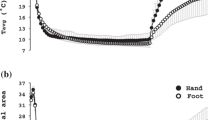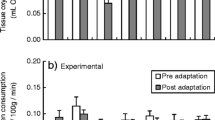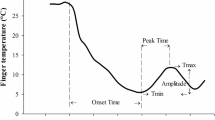Abstract
The aim of this study was firstly to describe the physiological responses observed in 19 subjects during immersion of the arm up to the elbow in water at 5 °C (5 min) followed by a 10-min recovery and secondly, to correlate the observed physiological responses with biometrical characteristics of the subjects (maximal oxygen uptake, VO2max, percentage fat content of whole body, BF, and arm, forearm and hand skinfold thickness). The results showed that the time courses of changes in forearm and hand skin temperature were different compared to those of finger skin temperatures both during local cooling and during rewarming (P < 0.05). Cardiovascular responses (heart rate, systolic and diastolic blood pressures) and finger skin temperatures were not related to the biometrical characteristics of the subjects. However, at the end of the immersion, decreased hand skin temperature was correlated to VO2max (r = 0.45, P ≤ 0.05) whereas decreased forearm skin temperature was correlated both to VO2max (r = 0.44, P ≤ 0.05) and to skinfold thickness (r = −0.44, P ≤ 0.05) but not to BF. During the beginning of the recovery period only, outside, inside forearm and hand skin temperatures were related to VO2max (r = 0.54, P ≤ 0.05; r = 0.66, P ≤ 0.01 and r = 0.45, P ≤ 0.05, respectively) and all the skinfold thicknesses (r = −0.47 to −0.71, P ≤ 0.05). It was concluded that the local skin temperature profiles differed according to the upper limb segment both during cooling and during early rewarming. Moreover, VO2max and upper limb skinfold thickness but not BF did influence the forearm and hand skin temperature changes during cooling and early rewarming but not the finger skin temperature changes and cardiovascular responses.
Similar content being viewed by others
References
Adams T, Smith RE (1962) Effect of chronic local cold exposure on finger temperature responses. J Appl Physiol 17:317–322
Astrand PO, Rodahl K (1977) Text book of work physiology. MacGraw Hill, New York, p 507
Bittel JHM, Nonotte-Varly C, Livecchi-Gonnot GH, Savourey GLM, Hanniquet AM (1988) Physical fitness and thermoregulatory reactions in a cold environment in men. J Appl Physiol 65:1984–1989
Boutelier C (1973) Echanges thermiques du corps humain dans l'eau. Thesis; Lille University, Lille p 215
Brown GM, Bird GS, Boag TJ, Delahaye JD, Green SE, Hatcher JD, Page J (1954) The circulation in cold acclimatization. Circulation 9:813–822
Du Bois D, Du Bois EF (1916) Clinical calorimetry tenth paper: a formula to estimate the approximate surface area if height and weight be known. Arch Int Med 17:863–871
Ducharme MB, Tikuisis P (1992) Forearm temperature profile during the transient phase of thermal stress. Eur J Appl Physiol 64:395–401
Elsner RW, Nelms JD, Irving L (1960) Circulation of heat to the hands of artic Indians. J Appl Physiol 15:662–666
Grant RT, Bland EF (1931) Observations on arterio-venous anastomoses in human skin and in the bird's foot with special reference to the reaction to cold. Heart 15:385–411
Hellström B, Andersen KL (1960) Heat output in the cold from hands of Attic fishermen. J Appl Physiol 15:771–775
Iampietro PF, Goldman RF, Buskirk ER, Bass D (1959) Response of negro and white males to cold. J Appl Physiol 14:798–800
Leblanc J (1962) Local adaptation to cold of Gaspé fishermen. J Appl Physiol 17:950–952
Leblanc J (1975) Man in the cold. Thomas, Springfield
Leblanc J (1992) Mechanisms of adaptation to cold. Int J Sports Med 13,51:S169-S172
Leblanc J, Cote J, Dulac S, Dulong-Turcot F (1978) Effects of age, sex and physical fitness on responses to local cooling. J Appl Physiol 44:813–817
Lewis T (1930) Observations upon the reaction of the vessels of the human skin to cold. Heart 15:177–208
Livingstone SD (1976) Changes in cold induced vasodilatation during Attic exercises. J Appl Physiol 40:455–457
Livingstone SD, Grayson J, Reed LD, Gordon D (1978) Effect of local cold stress on peripheral temperature of Innuit, Oriental and Caucasian subjects. Can J Physiol Pharmacol 56: 877–881
Lohman TG, Boileau RA, Massey BH (1975) Prediction of lean body mass in young boys from skinfold thickness and body weight. Hum Biol 47:245–262
Meehan JP (1954) Racial and individual differences in the peripheral vascular response to a cold stimulus. Am J Physiol 179:547–661
Moriya K, Nakagawa K (1990) Cold-induced vasodilatation of finger and maximal oxygen consumption of young female athletes born in Hokkaido. Int J Biometeorol 34:15–19
Paik KS, Kang BS, Hans DS, Rennie DW, Hong SK (1972) Vascular responses of forearm Korean ama to hand immersion in cold water. J Appl Physiol 32:446–450
Parizkova J, Poupa O (1963) Some metabolic consequences of adaptation to muscular work. Br J Nutr 17:341–345
Purkayastha SS, Ilavazhagan G, Phil M, Ray US, Selvamurthy W (1993) Responses of arctic and tropical men to a standard cold test and peripheral vascular responses to local cold stress in the arctic. Aviat Space Environ Med 64: 1113–1119
Savourey G, Clerc L, Vallerand A, Leftheriotis G, Mehier H, Bittel J (1992a) Blood flow and muscle bio-energetics by 31P-nuclear magnetic resonance after local cold acclimation. Eur J Appl Physiol 64:127–133
Savourey G, Vallerand A, Bittel J (1992b) General and local cold adaptation after a ski journey in a severe arctic environment. Eur J Appl Physiol 64:99–105
Savourey G, Barnavol B, Caravel JP, Feuerstein C, Bittel J (1996) Hypothermic general cold adaptation induced by a local cold acclimation. Eur J Appl Physiol 73:237–244
Takano N, Kotani M (1989) Influence of food intake on cold induced vasodilatation of finger. Jpn J Physiol 39:755–765
Yoshimura H, Iida T (1952) Studies on the reactivity of skin vessels to extreme cold. II. Factors governing the individual difference against frostbite. Jpn J Physiol 2:177–185
Author information
Authors and Affiliations
Rights and permissions
About this article
Cite this article
Savourey, G., Sendowski, I. & Bittel, J. Biometrical characteristics and physiological responses to a local cold exposure of the extremities. Europ. J. Appl. Physiol. 74, 85–90 (1996). https://doi.org/10.1007/BF00376499
Accepted:
Issue Date:
DOI: https://doi.org/10.1007/BF00376499




